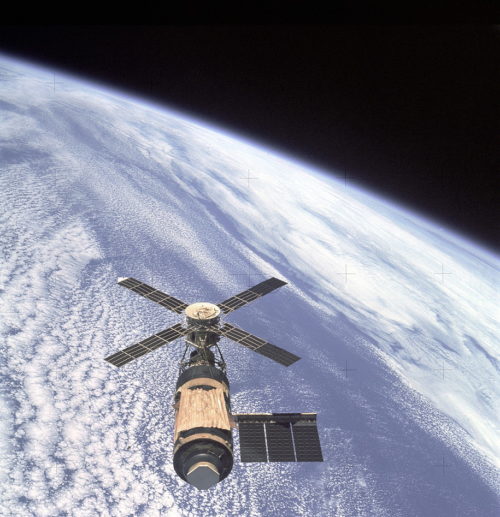
One of the final views of Skylab in orbit, as seen directly by human eyes, during the departure of the third crew in February 1974. The station, which began its slow descent back to Earth 40 years ago, this summer, was the largest single object ever launched into space. Photo Credit: NASA
Forty years ago, this summer, America’s first space station, Skylab, breathed its last and commenced a slow descent back to Earth, eventually to burn up in the atmosphere. The vast complex—a converted Saturn V S-IVB third stage, which remains the largest and most massive single object ever launched into orbit on a single booster—had been launched in May 1973, but had endured near-calamity from the start: a troubled ascent had seen its micrometeoroid shield torn away, one solar array ripped off and another clogged with debris.
Once in space, the sterling efforts of three astronaut crews over the next nine months had brought Skylab back to life, repaired it and achieved spectacular scientific results. Hundreds of hours of solar and astronomical observations were made, together with dozens of Earth resources studies and a vast corpus of biomedical data aided our understanding of how the human body functions in space over long periods of time.
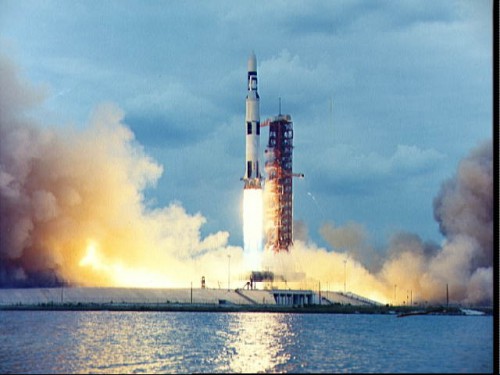
Launched in May 1973 atop the final Saturn V, the mission of Skylab almost ended before it had even begun. Photo Credit: NASA
But in the five years after the last crew departed Skylab in February 1974 and the old station’s eventual demise in July 1979, it was virtually abandoned. Its atmosphere was remotely vented, most of its systems were shut down and it was established in a gravity-gradient stabilized attitude, still capable of responding to telemetry commands, but with a troublesome control moment gyroscope and erratic coolant loops there seemed little likelihood that Skylab would again be occupied.
As the decade wore on, the sole chance of saving the station was with the shuttle, which was targeted to undertake its maiden voyage in 1979. Solar activity and its effect upon the upper atmosphere assured many NASA managers that Skylab could endure until the early 1980s and plans were set in motion for a potential shuttle reboost. In September 1977, the space agency initiated a two-year program to build hardware and Martin Marietta was contracted to study the feasibility of fabricating a boxy Teleoperater Retrieval System (TRS), to be deployed by an early shuttle crew to remotely dock and either reboost Skylab or cause the station to deorbit safely over an uninhabited stretch of ocean. Delivery of the $26 million TRS was slated for August 1979, with launch targeted for September, on a mission which included veteran astronauts Fred Haise and Jack Lousma.
Years later, Lousma recalled what would have been a five-day flight. He and Haise would have maintained a position about 1,000 feet (300 meters) from Skylab, after which Lousma would have deployed the TRS with the shuttle’s robotic arm and maneuvered it “like a radio-controlled airplane” to dock at the station. “The mission had never been planned to begin with, so the shuttles didn’t have rendezvous radar,” he told the NASA oral historian. “Fred got busy and started getting that implemented and also developing rendezvous procedures. I worked with Martin Marietta [as] the lead on the development [of the TRS].” In many minds, however, the mission was a waste of time and money, with even then-NASA Administrator Robert Frosch considering the chances of pulling it off as only 50/50.
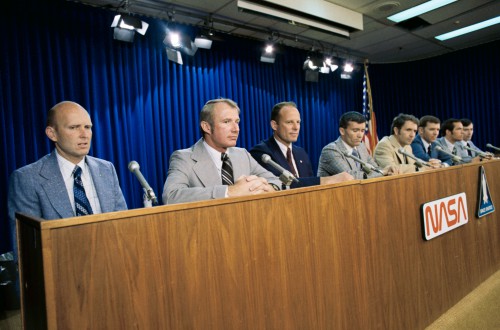
In March 1978, a “pool” of crew members were announced for the first four Orbital Flight Tests (OFTs) of the shuttle. Among them were Jack Lousma (third from left) and Fred Haise (fourth from left), who might in an alternate history have flown the salvage mission to Skylab. Photo Credit: NASA
What really spelled doom for Skylab in the summer of 1979 was a marked increase in solar activity and its effect upon Earth’s atmosphere. Early calculations predicted that increased atmospheric density would make the station’s orbit susceptible to drag, dropping by around 18 miles (30 km) in altitude by 1980, and faster in the years thereafter, before finally burning up around March 1983. However, as the next solar maximum period neared, NASA was cautioned that the Sun was more active than anticipated, with particularly intense sunspot activity.
Even if the mission to save Skylab did go ahead, it was a risky endeavor. “We knew that Skylab wasn’t just sitting there motionless, waiting to be docked with, but it was actually augering through the sky with a motion that made the nose of it wobble in a circle,” Lousma reflected later. “When we designed the [TRS] booster package, it had to be capable of being flown so it could match that wobble of the docking port around a centerline. I had to fly that booster over there and match the circular motion and have enough power in the control system to make sure that could be done. We simulated [the] known wobble of the Skylab and made sure we could get to that, then we added to it and made a bigger wobble, so we could size the control system. That was part of the development.”
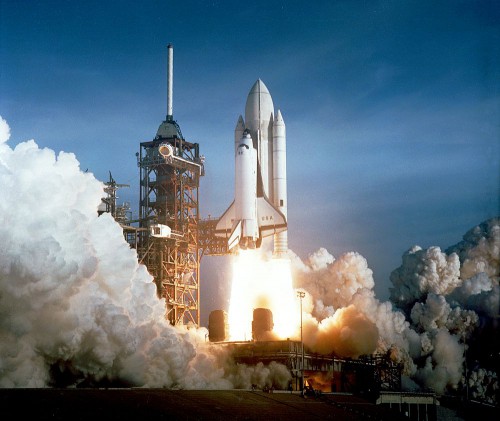
Two years later than planned, the Space Shuttle program got underway in April 1981. It was sadly too late, however, to salvage Skylab. Photo Credit: NASA
In the meantime, in February 1978, NASA made an initial contact with Skylab via the Bermuda tracking station and gradually, system by system, the aging hulk was brought back to life. However, with the shuttle’s maiden voyage planned for no sooner than late 1979, the chances of saving Skylab became increasingly remote. In December 1978, two separate test-stand failures of the Space Shuttle Main Engines (SSMEs) hammered the final nail into the coffin, delaying the first flight of the reusable orbiter until at least 1980. At about the same time, the North American Aerial Defense Command (NORAD) predicted the Skylab would deorbit in July or August 1979.
On 19 December, it was announced that NASA would henceforth focus its energies upon ensuring that Skylab could execute a controlled re-entry, without causing injuries or damage on the ground. Population density maps made this a troublesome effort, with a one-in-152 chance that someone might be hit by falling debris. The loss of the Soviet Union’s nuclear-powered Cosmos 954 satellite over Canada in January 1978 had upped the political stakes to avoid a disastrous re-entry and in January 1979 Skylab was placed into a solar-inertial, high-drag attitude.
During re-entry, and particularly during the so-called “terminal phase of decay”, at an altitude of around 77 miles (125 km), its stabilizing control moment gyros would be switched off. This would cause Skylab to tumble and the known lower drag effects associated with a tumbling configuration would result in a more predictable re-entry location and impact footprint. Other minor adjustments could also be made to its attitude to slightly increase or decrease atmospheric drag effects and thus lengthen or shorten the re-entry, but independent studies predicted that several large pieces of Skylab would probably survive the passage through the atmosphere.
The impact date, which was steadily refined by mid-June 1979 to sometime between 7-25 July, was expected to create a debris footprint 4,000 miles (6,400 km) long and 100 miles (160 km) wide. Finally, as July dawned, it was decided that the station would indeed be placed into an end-over-end tumbling motion during re-entry, thereby offering a more accurate prediction of its impact point. NORAD anticipated impact on the 12th and as controllers watched and listened, Skylab’s six years in orbit finally came to an end.
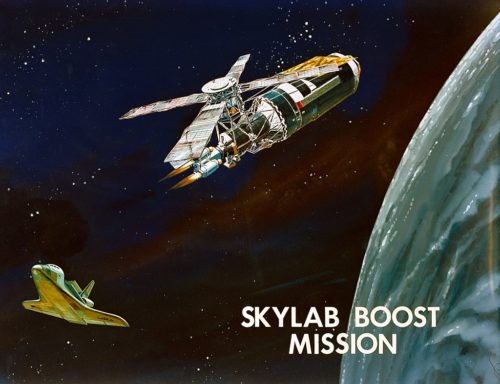
Artist’s concept of the shuttle rendezvous with Skylab and the engines of the Teleoperator Retrieval System (TRS) either reboosting the old station or enabling it to deorbit safely. As circumstances transpired, the Sun and the expansion of Earth’s atmosphere, together with delays to the shuttle program, solved the problem. Image Credit: NASA
In the official Skylab Reactivation Mission Report—published by NASA in March 1980—the majority of the break-up occurred between the altitudes of 37-60 miles (60-95 km): in sequence, the sole remaining solar panel was torn away by steadily increasing aerodynamic forces, after which the Apollo Telescope Mount (ATM) and the main part of Skylab were separated and the solar observatory’s windmill of arrays came apart. Final disintegration most likely occurred some 37 miles (60 km) above Earth. One of the earliest visual sightings was from an airline pilot, flying along Australia’s west coast, who reported an intense fireworks show, as multiple streaks of debris snaked across the sky.
“The actual vehicle was stronger than the specs required,” wrote David Hitt, Owen Garriott and Joe Kerwin in their seminal work on Skylab, Homesteading Space. “It held together longer than was calculated, breaking up over the Indian Ocean. Most of the debris fell harmlessly into the water, but some chunks fell in Western Australia, along a line from south to northeast of Perth.” It was a sad end for a program which had for a few years in the early-mid 1970s placed the United States ahead of the Soviet Union in terms of long-duration spaceflight; with its three crews having logged 28 days, 59 days and 84 days in orbit.
.
.
FOLLOW AmericaSpace on Facebook and Twitter!
.
.




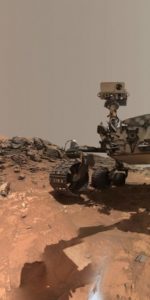
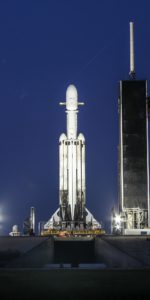
Some of the debris that hit the ground was fairly large. I saw a picture of a person inspecting the remains of a tank that would have barely fit into the cargo bay of their pickup. A couple woke up during the night and heard what sounded like hail outside.
One of my first experiences as a new Orbital Analyst for the US Air Force was working on the Skylab reentry; it has left me with a long term interest in events like this. I was told, after the event, that NASA put the station into a tumble and turned off the computer so it would not try to stop tumbling – but that the station went LOS and when it came back AOS the computer was on and the tumble had stopped!
We had a “cottage” industry of running the decay prediction until the impact point was on a major city – and then printing ten copies of the image to hand out to friends!